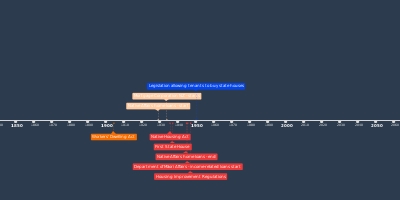jul 30, 1991 - Statement of Government Policy on Housing and Accommodation
Description:
In a companion volume to Welfare that Works, the Minister of Housing (Hon John Luxton) announced a new framework for housing assistance. It was considered that the conflicting commercial and social roles of the Housing Corporation had created difficulties in achieving and efficient and rational approach to the provision of accommodation assistance.The reforms included:
• all demand-side housing assistance to be provided through a single Accommodation Supplement delivered by the Department of Social Welfare;
• for Housing Corporation and Iwi Transition Agency rental clients, rents would be increased to market rents over the next two years (from 1 July 1993 state tenants would pay rents based on the cost of their accommodation);
• state tenants in rental accommodation that was not suited to their needs (eg larger houses) or in a high rent areas, were to be offered assistance to move to better matched accommodation (a cash payment of $500 to those who decided to move within the same rent district to better matched accommodation and $1,000 to those who decided to move to a lower cost rent district to achieve better matched accommodation). No state tenants would be forced to move;
• in cases of frail or elderly tenants or where a house had been modified to accommodation a particular disability, these people were to be able to remain in the accommodation for as long as they wished and their rents were protected (initially through a rent-rebate, then from 1 July 1993, through the Tenure Protection Allowance).
• the 69,500 state houses would be transferred to a new State Owned Enterprise, to be managed on a commercial basis, in an environment that would lead to a better use of the housing stock. Day to day management would be handled by executives of the company who would report to a Board of Directors. The Board would appointed by, and accountable to, the Government [Housing New Zealand Ltd, was established on 1 July 1992];
• the responsibility for policy advice, the administration of the Residential Tenancies Act 1986 and other non-commercial activities of the Housing Corporation would be shifted to other Government departments;
• the Housing Corporation would be retained as a legal entity to own the $3.8 billion mortgage portfolio (around one-fifth of the value of the New Zealand mortgage market) and the future of this business would be subject to review;
• the Housing Corporation’s prime rate mortgages were to be offered for sale; and
• the Homestart Deposit Scheme (to assist low-income families into home ownership) would cease (of the $600 million loaned, it was estimated that there were going to be difficulties in getting around $200 million repaid on schedule).
[Note: From 1 July 1993, the Accommodation Supplement covered only 65 percent of the difference between a tenant’s rent and the market rent, so state tenants’ expenditures on rent increased. State house rents rose by 106 percent from 1990 to 1999 (by contrast, rents in the private sector rose over the same period by only 23 percent), and, by the late 1990s, approximately 60 percent of state housing tenants were paying more than 30 percent of their income in rent. In 2000, the new Labour Government reinstated income-related rents for state housing tenants.]
Source: https://www.msd.govt.nz/about-msd-and-our-work/about-msd/history/social-assistance-chronology-programme-history.html
Added to timeline:
Date:
jul 30, 1991
Now
~ 34 years ago
